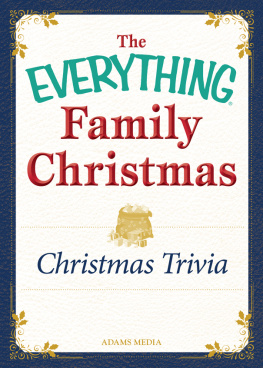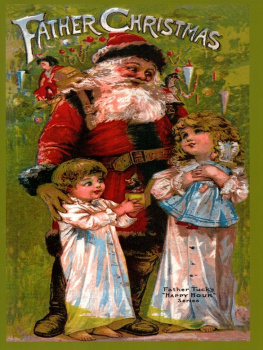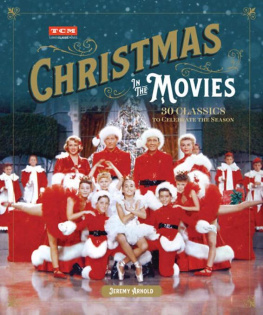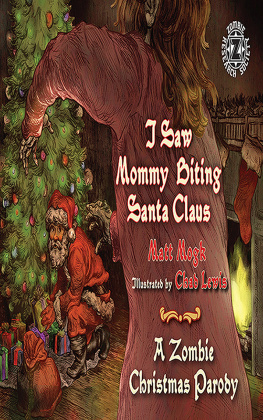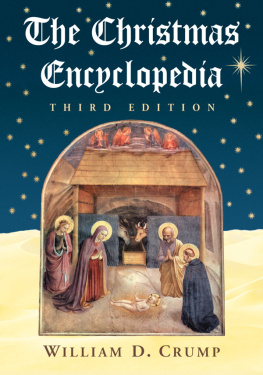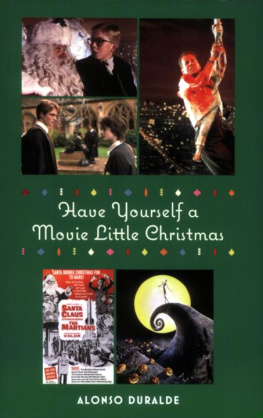How the Movies Saved Christmas
228 Rescues from Clausnappers, Sleigh Crashes, Lost Presents and Holiday Disasters
WILLIAM D. CRUMP

McFarland & Company, Inc., Publishers
Jefferson, North Carolina
LIBRARY OF CONGRESS CATALOGUING DATA ARE AVAILABLE
BRITISH LIBRARY CATALOGUING DATA ARE AVAILABLE
e-ISBN: 978-1-4766-2770-0
2017 William D. Crump. All rights reserved
No part of this book may be reproduced or transmitted in any form or by any means, electronic or mechanical, including photocopying or recording, or by any information storage and retrieval system, without permission in writing from the publisher.
On the cover: Rudolph, the Red-Nosed Reindeer, 1964 (NBC/Photofest); Christmas background decorations 2017 aykuterdogan/iStock
McFarland & Company, Inc., Publishers
Box 611, Jefferson, North Carolina 28640
www.mcfarlandpub.com
To my Mother
Mary Frances Drake Crump
in whose home
Christmas never had to be saved
Preface
While I was writing the first edition of The Christmas Encyclopedia, one of my now-late aunts asked, What can you write about Christmas thats not already in the Bible? Yes, she was quite serious. Well, how about Miracle on 34th Street or A Christmas Story or Dr. Seuss How the Grinch Stole Christmas for starters? Theyre not biblical, but they and a host of other movies are just as much a beloved part of the Christmas tradition as the biblical account of the birth of Christ. Had my aunt been alive today and had she known of the present work that I had undertaken, she undoubtedly would have asked, What is there about Christmas that needs to be saved? Perhaps some feel that Christmas must be saved from all the secularism and materialism that presently surround the holiday; in short, put Christ back in Christmas. Perhaps others feel that Christmas must be saved from antiChristmas-ians who wage the so-called War on Christmas with political correctness; who, for example, insist on the generic Happy Holidays or Seasons Greetings over Merry Christmas, holiday trees over Christmas trees, and who stir up legal battles to prohibit the appearance of religious Christmas symbols like Nativity scenes in public places. I happily leave those particularly controversial issues to social, religious, and political analysts.
From the standpoint of the film industry, which is the focus of this book, the reasons for saving Christmas in the movies (movies being a generic word that encompasses theatrical releases; TV movies, series, and specials; and animated cartoons) vary widely from the religious and sublime to the ridiculous and comical and even to the macabre and bizarre. After researching more than 3,300 Christmas films, I found 228 with saveChristmas themes to showcase here. It is not the purpose of this book to present every saveChristmas film thats ever been made, principally for three reasons: (1) some are so outrageously blasphemous that they are far beyond serious consideration; (2) some are not available for viewing and lack sufficient details; (3) others are in the pre-production phase and will be released after the manuscript has been submitted for publication. Rather, I include a whole slew of examples that demonstrate a broad spectrum of reasonably tasteful-yet-sometimes-a-bit-spicy reasons for saving Christmas. I note 53 different reasons and group the films accordingly in a list in the back of this book for quick reference. The top five reasons for saving Christmas are, in descending order: Santa Claus or Santa surrogate or elves or reindeer are sick, injured, or incapacitated (36 films, eight of which depict Santa suffering from amnesia); villains sabotage or take over the North Pole (29 films); Santa crashes his sleigh (24 films); Christmas decorations and/or presents are lost or stolen (18 films); protagonists lose the Christmas spirit (17 films). Its not among the top five, but in one interesting group of 10 films, Santa is kidnapped.
Thus, a good percentage of saveChristmas films focus on the materialistic importance of Santa and his delivering the presents to having a successful Christmas. In a typical plot scenario, if a villain or other bogey jeopardizes Santas delivery, there will be no Christmas unless the villain is vanquished, because in those movies, Christmas is all about Santa; the birth of Jesus is rarely ever mentioned (although in Saving Christmas, for example, Kirk Cameron attempts to put Christ back in Christmas). Time and again, characters utter typical statements such as, There wont be a Christmas without Santa or Without Santa, Christmas will be ruined. So, when characters exclaim, Weve got to save Christmas! they usually mean that Santa and gang are in trouble, which means that Christmas is in trouble; no Santa, no Christmas. A completely different sentiment is found in movies like Dr. Seuss How the Grinch Stole Christmas in which the Whos gladly welcome Christmas without material gifts; such idealistic sentiment is lacking in the majority of saveChristmas films, however.
Because Santa is a prime figure here, its not surprising to note that over half of the films presented are animated and directed at children, especially preschoolers, yet teens and adults will surely find flicks that pique their interest. Although the majority of the films originate in the United States, this book includes a sizeable number produced in foreign countries, either alone or in combination with the United States: Australia, Belgium, Canada, China, Denmark, Finland, France, Germany, India, Ireland, Italy, Japan, Luxembourg, Mexico, Netherlands, New Zealand, South Korea, Spain, Sweden, Switzerland, and the United Kingdom. Most, but not all, of the films are on either DVD, VHS, Amazon Instant Video, Hulu, Hoopla, YouTube, or Netflix. However, just because they are saveChristmas films that often focus on Santa, not all are rated G with fluffy animals and stupidly grinning elves; while many are not rated, the more spicy films bear the PG and R brands, so look out!
Despite the focus on saving Christmas, a number of films herein take on a more ecumenical tone by either mentioning Hanukkah in passing or showing a conspicuous menorah. Those saveChristmas films that give a nod to Hanukkah include Beauty and the Beast: The Enchanted Christmas;Billy and Mandy Save Christmas; Im Dreaming of a White Ranger; A Muppets Christmas: Letters to Santa; Olive, the Other Reindeer; Road to the North Pole; Santa Switch; Save the Reindeer; Twas the Night Before Bumpy; and Uncle Grandpa: Christmas Special. Kwanzaa and Ramadan receive far less attention, Save the Reindeer and A Tale of Two Santas being the only films in this book that mention Kwanzaa, while Olive, the Other Reindeer is the only film here that mentions Ramadan. And to turn things around a bit, The Hebrew Hammer focuses on saving Hanukkah from an evil Santa.
All films are presented alphabetically by title. Each film includes the date of release; brief statements about what threatens Christmas and how the holiday is saved; a synopsis and commentary with principal cast members (for live-action movies); principal voices (for animated movies); production credits (writers, producers, directors, production companies, rating, genre, country of origin, run time); and references. Where applicable, each film also includes awards, interesting tidbits and noteworthy information not found in the synopsis, and excerpts of reviews from professional critics. Episodes from television series include brief background information about the series for the benefit of readers who are otherwise unfamiliar with the characters; I leave detailed histories to the Internet. All films are in color unless otherwise indicated. Titles in




